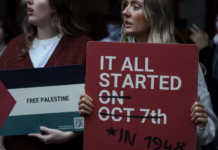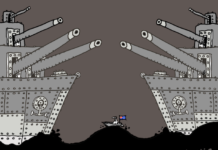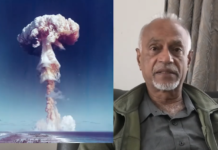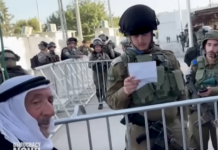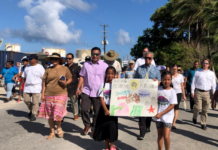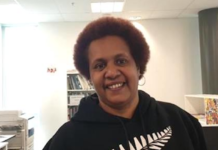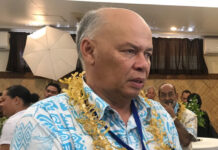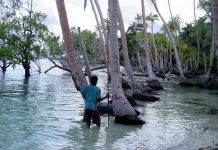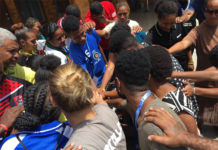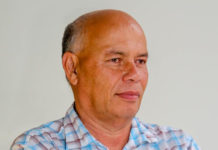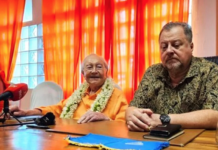
REVIEW: By Margaret Scott
Many years ago during Suharto’s dictatorship, when the mass killings of 1965-66 were a taboo subject, I interviewed Pramoedya Ananta Toer, one of Indonesia’s greatest writers, who was living under house arrest in Jakarta after his release from a decade of brutal existence as a political prisoner on Buru island.
Those interviews with Pak Pram, as he was known, were revelatory to me, a young US journalist who knew next to nothing about the botched coup of 1 October 1965, which the army blamed on the Communist Party of Indonesia (PKI), and then used as a pretext to massacre up to a million suspected communists and imprison another million Indonesians, including Pak Pram.
I took a deep dive into this little known chapter of the Cold War in my attempt to understand Pram’s role as a fellow traveller and leading leftist intellectual before 1 October, and then a locked-up, banned and silenced writer after Suharto and the army seized power.
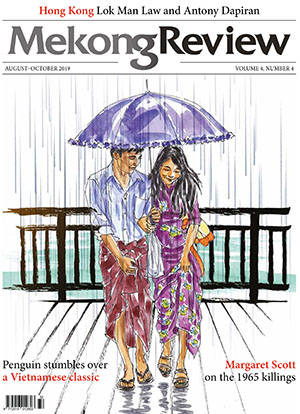
Back then, facts were hard to come by. It was dangerous to challenge the official narrative that the army saved the nation and that the people rose up in a frenzy to annihilate the PKI. After Suharto was toppled in 1998 and Indonesia entered its cacophonous yet fragile democratic era, a battle over memory and history erupted over the events of 1965.
While the official narrative still prevails and continues to be taught to schoolchildren, that official narrative has been debunked by scholars, journalists, writers and political prisoners who survived the killings. The ongoing excavation of the hidden history of what happened is crucial for Indonesians, but it is also important for citizens of the US, UK and Australia to understand the role their governments played in supporting the mass killings and then helping to hide them.
These three new books add, in very different ways, needed pieces of the complicated mosaic explaining why so many were killed so quickly, what happened to the political prisoners who weren’t killed and why the army and civilian militias who carried out most of the killings have never been held accountable.
The survivors
Vannessa Hearman’s Unmarked Graves: Death and Survival in the Anti-Communist Violence in East Java, Indonesia focusses on one province, East Java, and after she explores who was behind the killings in the province, she digs into what happened to the PKI members and other leftists who survived and how they responded to the violence. Hersri Setiawan, like Pramoedya, was banished to Buru, and his Buru Island: A Prison Memoir paints a wrenching portrait of life as a political prisoner, robbed of all rights and human dignity. The third volume, The International People’s Tribunal for 1965 and the Indonesian Genocide, is a collection of essays that delve into the different categories of crimes against humanity committed by the army and its proxies during the state-sponsored annihilation campaign, and adds the crucial dimension of the complicity of the US and the UK in providing propaganda and material support.
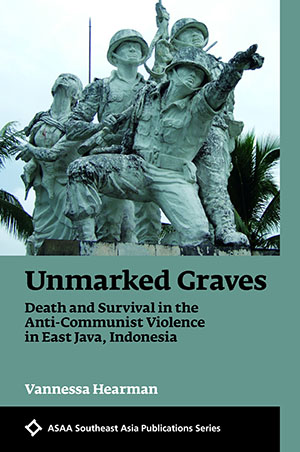
Hearman, a historian who lectures at Charles Darwin University, spent years researching Unmarked Graves. Through her extensive interviews, Hearman describes what happened in East Java as the news spread from Jakarta that in the early hours of 1 October six high-ranking army generals were snatched from their homes and murdered by left-leaning junior officers who called themselves the 30 September Movement.
They claimed they were forestalling a coup by a CIA-backed group of anti-communist generals. Within hours, the junior officers were out-manoeuvred by Major General Suharto, who staged a counter-coup and blamed the Communist Party of Indonesia (PKI) for the murders.
The army took control of all newspapers and radio, and the propaganda – including the fake and endlessly repeated story of how Communist women danced around the kidnapped generals as they castrated them and gouged out their eyes – played a huge part in whipping up support within Muslim militias, mostly organised by the army, for rounding up, detaining and then killing suspected communists.
Within twenty-four hours, the 30 September Movement collapsed. PKI members in East Java, like the rest of the archipelago, were stunned and did not know what to do as the communists were blamed. East Java was a stronghold of the PKI, which by then was the third largest communist party in the world. East Java also has long been a mainstay of Nahdlatul Ulama (NU), a mass-based Muslim organisation that opposed the PKI.
Hearman describes how the army turned to NU and its youth militias, known as Ansor, gave them weapons and turned them into willing executioners of those deemed to be linked to the treacherous PKI. She writes that as early as 5 October, NU leaders in the East Java town of Kediri met with army officers and agreed to work together. On 8 October, NU and other Muslim leaders gathered in the town of Jamsaren: “It was agreed that among the organisations present, NU would take a leading role in eradicating the PKI in the coming weeks”.
The first killings in East Java began in Kediri on 13 October. Some NU leaders sanctioned the killings; the head of a NU religious school in the town of Situbondo declared that “the PKI’s blood was halal”. In describing how the killings spread across the province, Hearman’s research echoes the harrowing patterns another Australian scholar, Jess Melvin, uncovered in Aceh and describes in her groundbreaking book, The Army and the Indonesian Genocide: Mechanics of Mass Murder.
Army documents
Melvin found a cache of 3,000 army documents that prove that the army deliberately planned the massacres, and she uses them to chronicle how the tactics and scale of the killings evolved in Aceh. Hearman, relying on interviews and archival material, found the army’s methods in Aceh were repeated. Public demonstrations against the PKI were followed by the creation of militias and death squads. In the first phase of the killings, there were public executions and mass round-ups. Then the killings would escalate.
“The first stage was demonstrative and open, while the second was routinised slaughter away from public eyes”, Hearman writes. By early 1966, the killings stopped. Some 200,000 people were murdered in East Java, the highest death toll across the archipelago of 17,000 islands.
During these months of terror, PKI members and the many farmers and workers who belonged to leftist mass organisations were terrified and bewildered. Hearman’s book furthers our knowledge of how party members went underground, developed networks to help each other survive and even devised a plan to resist.
Her use of interviews with survivors is uneven and the writing is often clunky, but her research comes alive in the second half of the book, when she tells the story of the creation and then the destruction of an underground PKI base in South Blitar, a poor and mountainous area of East Java that sits between the Brantas River and the Indian Ocean.
The remarkable history of the South Blitar base is little understood, and Hearman’s research is an important contribution. By December 1966, the PKI was decimated, most of its leaders had been killed or detained, and it had been banned. Word went out from what was left of the party leadership that survivors should head to South Blitar. “In moving to South Blitar, the party leaders attempted to resurrect the organisation and to spearhead a resistance movement to the New Order regime,” Hearman writes.
Party leaders invoked Mao’s Long March to a base in Yenan, China, where he rebuilt the Chinese Communist party and then emerged victorious in 1949. South Blitar, the surviving PKI leaders wrote in a report, was to be their Yenan. This turned out to be a delusional plan, but it shows both how fluid the political situation was and how desperate the party was to return to its former strength. Hearman writes that the survivors of South Blitar were reluctant to talk about the base since, as delusional as it was, its existence gave credence to the army’s propaganda that Communists were plotting a comeback. Suharto’s New Order invoked the “latent danger of communism” to create an elaborate intelligence apparatus that reached down to the village level to quash dissent or signs of leftism. The base in South Blitar provided perfect proof.
In fact, according to Hearman’s research, while scores of PKI members made their way to South Blitar, guided by an underground network of couriers, they barely survived, and it was a struggle to find weapons and avoid army spies. Once the army discovered the base, it was eradicated through a full-scale military invasion, called the Trisula Operation, which lasted from June to September 1968.
Guerrilla force planned
Some 5,000 soldiers and 3,000 civilians, including NU militias, were involved, and 2,000 supposed members of the base were killed. One of the PKI leaders who was there told Hearman that they had plans for a 150-strong guerrilla force, but they were not yet active when the army launched Trisula. After it was over, the army said thirty-four pistols or firearms, fifty-seven sharp implements, 2,700 bullets and fourteen hand grenades were seized.
Tuti is the pseudonym Hearman gives to a woman who was the East Java leader of Gerwani, a leftist women’s organisation that was the brunt of the false propaganda that leftist women had tortured the generals on 1 October.
Tuti worked on literacy programmes and land occupations for the PKI. She went underground after the killings began, and eventually made her way to South Blitar. She told Hearman that the she and other PKI members had to resist or be killed. She was captured during the Trisula Operation, and eventually sentenced to twenty years for setting up a “Democratic People’s Republic”.
Tuti was released in 1988, and lived as a non-person. Her two daughters were wary of her, and didn’t want anyone to know of her past. She died in 2012.
Of the PKI members who were not killed in South Blitar, most were imprisoned like Tuti. For the people of South Blitar, largely subsistence farmers who endured years of army surveillance and forced relocations after the Trisula Operation, a sense of collective victimhood took hold.
For Suharto and his New Order, the obliteration of the rump PKI base, memorialised in a huge monument, showed the army’s absolute dominance and that the New Order was here to stay.
The next year, in 1969, the New Order came up with another plan to erase what remained of the left: some 12,000 political detainees, many of them artists and intellectuals, were shipped to Buru and forced to hack away the jungle and build their own barracks and farming plots. Pramoedya, after four years in a Java prison, was part of the first shipment of detainees to the mostly uninhabited and unforgiving island in the Moluccas.
Life on Baru
Another leftist poet and writer, Hersri Setiawan, wrote Buru Island, a searing record of daily life on Buru: the brutality, the hunger, the beatings and the long days in the hot fields desperate to grow enough to eat. Setiawan, who belonged to the same leftist cultural movement as Pramoedya, was sent to Sri Lanka (then Ceylon) to represent Indonesia in the Asia Africa Writers Bureau, but was kicked out by the colonial government in August 1965.
Partly because he had been away and partly because the military intelligence did not know his face, Setiawan writes that he played cat and mouse with the authorities for four years before he was arrested. He lived underground in Jakarta and kept some contact with other PKI comrades.
In an eerie echo of Hearman’s book, Setiawan describes a courier finding him in December 1966 and telling him the party leadership has ordered him to join the Long March to the base in South Blitar. He explodes, and says he won’t go. The courier asks why.
“I am sure you also listen to the broadcasts of Radio Peking. It would be strange if you didn’t. And how many times a day does that radio antennae blast out the news about the base in South Blitar? One little spark burns a whole field, it says!”, Setiawan writes of his answer. He asks the courier to tell the party leadership that the no one could survive the army anywhere on Java.
Setiawan refuses to go to South Blitar, but the army does find him. And, in 1971, it is his turn with 850 others to be shipped to Buru. He describes arriving on Buru and marching barefoot for hours through tall and sharp jungle cogon grass to their barracks.
“The law is in our hands”, the guard tells the new exiles, “we can kill you whenever we want”. As they reach the spare, tin-roofed barracks built by prisoners already there, the guard adds: “That’s where you will eat, drink, sleep, work, and … don’t forget … pray. Forever. Until you die.”
Bird’s eye view
Buru Island offers a bird’s eye view of what the prisoners endured, but there is a lot of repetition, as though he wrote snippets and then pieced them together without shaping the narrative. Setiawan, though, is a keen observer of the generational and ideological rifts that divide the prisoners, and he gives a fragmentary record of how the prisoners struggle to make sense of their collapsed world.
He also pays close attention to language, and his translator, the veteran Jennifer Lindsay, nimbly conveys in English the nuances, regional differences and playfulness of the Indonesian language.
She captures Setiawan’s focus on the slang and wordplay of the prisoners, as well as the language used by the soldiers to show their resentment of the more educated prisoners from Java. The army refers to the Buru penal colony as a “humanitarian project” and a “utilisation location”, meaning a place to put prisoners to work.
Those euphemisms and other false news or propaganda are derided by the prisoners as bom boman, or dropping bombs. Informers are called cockroaches. The shakes of a malarial fever become riding a Honda motorbike. And the slang for being killed in prison is “Mangkubumi,” a reference to a cruel tyrant and the translation of mangku, meaning embrace, by bumi, the earth.
Over time, Setiawan describes shifts in the attitudes of many prisoners. Young people feel betrayed by the PKI leadership and are less willing to defer to the older leaders. He writes that there is a move away from a collective spirit and solidarity, and towards a liberal, individualistic, each-for-himself spirit. Setiawan laments this change.
By the mid-1970s, a new commander eases up on the brutal conditions. Setiawan is asked to write a report on the importance of culture he changes the language from people’s culture to the culture of Pancasila, the New Order’s ideology for the commander. Soon, a whole set of musical instruments arrives, and a “Command Band” is set up. A while later, the commander allows a special barracks for prisoners with skills. A wayang kulit or shadow puppet troop forms, and so does an engineers group. Finally, Pramoedya is designated a writer and given a typewriter and paper.
On Buru, Pram conceived and wrote four historical novels that tell the story of the emergence of Indonesia, known as The Buru Quartet, which now top any list of the classics of Indonesian literature. During our interviews more than twenty years ago, Pram, who died in 2006, told me that he first told the stories to other prisoners as he worked out the plot.
Copies bartered for food
When he was finally given permission to write, he asked for carbon paper so he could have multiple copies. He used the copies as barter for food and cigarettes. All his writing was confiscated when he was finally released from Buru, but his fellow prisoners compiled the carbon copies they had secretly saved, and the novels were published. They were immediately banned. After 1998, Pram’s house arrest was lifted and his novels were reissued.
In late 1978 Setiawan hears that many prisoners are returning to Java. His name is on the list. On his last day, he writes, he goes to the prison hospital where his old friend, Heru Santoso, is dying. On Buru, Santoso and Setiawan worked together closely, figuring out how secretly to harvest sago from a swamp and how to rig up pipes made of bamboo to bring running water to their barracks. But one day, Setiawan writes, “Heru Santoso exercised the one and only right left to a prisoner. The right to escape.”
Santoso lasted on the run for more than a week. Back in prison, his health deteriorated and now he was dying of cirrhosis of the liver. Setiawan writes of their tearful farewell and of Santoso telling him to leave Buru with a light heart. As Setiawan leaves, Santoso ever so slowly raises his right arm and makes a fist. “It was as though he wanted to give me a final eternal message. Be resolute!”
The release of Buru prisoners in 1979 was the result of a sustained campaign by Amnesty International and other human rights organisations. But in Indonesia they continued to be stigmatised, seen as polluted and prevented from holding government jobs or working as journalists or teachers. Pram lived under house arrest. Setiawan eventually moved to the Netherlands.
Since Suharto was toppled, there has been a steady stream of memoirs, documentaries and novels dealing with 1965. Buru Island is the fourth book published by the important Herb Feith Translation Series and Monash University. These books, all translated by Lindsay, are designed to increase understanding outside Indonesia of how the mass killings continue to shape Indonesia.
These Indonesian voices in translation add to the important scholarly work that has shattered the official narrative, especially John Roosa’s Pretext for Mass Murder, Geoffrey Robinson’s The Killing Season: A History of the Indonesian Massacres, 1965–66 and Melvin’s book on Aceh. Efforts to uncover the past atrocities gathered momentum when Joko Widodo, known as Jokowi, was elected president in 2014. Jokowi promised to bring open, pluralist rule to Indonesia’s 250 million people, and many hoped that he would end the impunity for past human rights abuses, starting with the 1965 massacre.
By this time, the Indonesian massacre had come into focus for many through Joshua Oppenheimer’s astonishing films, The Act of Killing (2012) and The Look of Silence (2014), which look at this dark chapter in the country’s history, first through the eyes of the killers and then of its victims.
Discussion shut down
Although there is an appetite, especially among young people, to know more about what happened in 1965, there has also been a fierce backlash from army generals and Islamist politicians who warn that any talk of reconciliation or apology is a plot to revive communism.
Hard-line Islamist groups and the army have shut down discussion groups, book openings and film screenings about the killings. Any effort to investigate the past is seen as a neo-communist threat to the nation. The democratic era has brought contested direct elections and a vibrant free press to Indonesia, but it has failed to dislodge either the immunity from investigation or prosecution enjoyed by the Indonesian army or the determination of elite politicians and Islamists to enforce silence on the killings.
In 2015, after years of pushing for accountability, a group of scholars, lawyers and transitional justice experts held an International People’s Tribunal in the Hague to codify the crimes committed in 1965- 66, with an eye on promoting rule of law and preventing the crime of silence, according to Saskia Wieringa, of the University of Amsterdam and one of the editors of the volume, The International People’s Tribunal for 1965 and the Indonesian Genocide.
Each essays delves into the different types of crimes against humanity enslavement, sexual violence and torture that were prosecuted at the tribunal.
The Hague tribunal had no enforcement powers, but it was an effort to record systematically what happened and who was responsible. Todung Mulya Lubis, a well-known Indonesian lawyer, was the chief prosecutor. He laid out the crimes of the state and showed that the army organised the killings and mostly used NU militias to carry them out.
Now Lubis is Indonesia’s ambassador to Norway, and it leaves a bad taste in the mouth of this reviewer that he has spearheaded the dubious campaign to have NU and Muhammadiyah, another mass Muslim organisation, nominated for the Nobel Peace Prize.
In an essay called “Propaganda and complicity, 1965-66”, Adam Hughes Henry, a lecturer at the Australian National University, writes poignantly about the complicity of the US, the UK and Australia. Their support for the extermination of the PKI, he writes, is “the very reason these events have never been subject to legal sanctions. US and British support for the army shielded the army from any potential legal sanctions outside Indonesia.”
Five young journalists and writers offer an interesting essay on Ingat65 or Remember65, an admirable online attempt to create a repository of stories and memories about 1965.
If the cycle of silence and impunity is ever broken, it will be at the hands of young Indonesians. But citizens of the US, the UK and Australia can help. First, they can call for the declassification of many crucial documents from the various diplomatic, military, and intelligence services that remain secret.
These new books should offer support for those searching for the truth. At the very least, they reveal the urgent need for a new official account of a tragic chapter in Indonesia’s past that continues to haunt the present.
- Vanessa Hearman (2018). Unmarked Graves: Death and Survival in the Anti-Communist Violence in East Java, Indonesia. Singapore: NUS Press.
- Hersri Setiawan (2019). Buru Island: A Prison Memoir (translated by Jennifer Lindsay).
Herb Feith Translation Series, the Herb Feith Foundation and Monash University, Melbourne. - Saskia E. Wieringa, Jess Melvin and Annie Pohlman (Eds) (2019). The International People’s Tribunal for 1965 and the Indonesian Genocide. London: Routledge.
- Margaret Scott teaches at New York University’s Wagner School of Public Service, contributes to The New York Review of Books and is a cofounder of the New York Southeast Asia Network. This review is republished from the August edition of Mekong Review.



